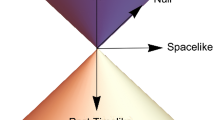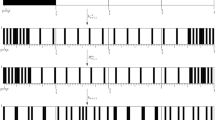Abstract
A differential manifold (d-manifold, for short) can be defined as a pair (M, C), where M is any set and C is a family of real functions on M which is (i) closed with respect to localization and (ii) closed with respect to superposition with smooth Euclidean functions; one also assumes that (iii) M is locally diffeomorphic to Rn. These axioms have a straightforward physical interpretation. Axioms (i) and (ii) formalize certain “compatibility conditions” which usually are supposed to be assumed tacitly by physicists. Axiom (iii) may be though of as a (nonmetric) version of Einstein's equivalence principle. By dropping axiom (iii), one obtains a more general structure called a differential space (d-space). Every subset of Rn turns out to be a d-space. Nevertheless it is mathematically a workable structure. It might be expected that somewhere in the neighborhood of the Big Bang there is a domain in which space-time is not a d-manifold but still continues to be a d-space. In such a domain we would have a physics without the (usual form of the) equivalence principle. Simple examples of d-spaces which are not d-manifolds elucidate the principal characteristics the resulting physics would manifest.
Similar content being viewed by others
References
S. W. Hawking and G. F. R. Ellis,The Large-Scale Structure of Space-Time (Cambridge University Press, Cambridge, 1973). See also, M. Heller,Questions to the Universe (Pachart, Tucson, 1986).
C. Chevelley,Theory of Lie Groups (Princeton University Press, Princeton, 1946).
K. Nomizu,Lie Groups and Differential Geometry (The Mathematical Society of Japan, Tokyo, 1956).
R. Penrose and W. Rindler,Spinors and Space-Time. Vol. 1: Two-Spinor Calculus and Relativistic Fields (Cambridge University Press, Cambridge, 1984), Chap. 4.
R. Sikorski,Wstep do geometrii rozniczkowej (An Introduction to Differential Geometry) (PWN, Warszawa, 1972).
M. A. Mostov, “The differentiable space structures of M. Milnor classifying spaces, simplicial complexes and geometric relations,”J. Diff. Geom. 225–293 (1979).
J. Gruszczak, M. Heller, and P. Multarzynski, “On a generalization of manifolds as space-time models,”J. Math. Phys. 29, 2576–2580 (1988).
For a fuller discussion of the equivalence principle, its different formulations (weak, strong, “superstrong”), and its relationship to the affine and metric structures of space-time, see D. J. Raine and M. Heller,The Science of Space-Time (Pachart, Tucson, 1981), pp. 117–129. See also, S. Weinberg,Gravitation and Cosmology (Wiley, New York, 1972), pp. 67–88; W. Rindler,Essential Relativity, revised edition (Springer, New York, 1977), pp. 15–22.
A. Pais,“Subtle is the Lord...”—The Science and Life of Albert Einstein (Oxford University Press, Oxford, 1982), Part IV; R. Torretti,Relativity and Geometry (Pergamon Press, New York, 1983), Chap. 5.
S. W. Hawking, “The path-integral approach to quantum gravity,” inGeneral Relativity —An Einstein Centenary Survey, S. W. Hawking and W. Israel, eds. (Cambridge University Press, Cambridge, 1979), pp. 746–789, pp. 894–895 (especially Sec. 15.10).
T. Appelquist and A. Chodos, “Quantum dynamics of Kaluza-Klein theories,”Phys. Rev. D 28, 772–784 (1983); M. B. Green, “Unification of forces and particles in superstring theories,”Nature 314, 409–414 (1985); V. M. Emel'yanov, Yu. P. Nikitin, I. L. Rozental, and A. V. Berkov, “Physics in multidimensional spaces and the beginning of metagalaxy,”Phys. Rep. 143, 1–68 (1986).
M. Demianski, Z. A. Golda, M. Heller, and M. Szdlowski, “The dimensional reduction in a multi-dimensional cosmology,”Class. Quantum Grav. 3, 1199–1205 (1986).
A. Kowalczyk, “The Riemannian curvature tensor and differentiable spaces,” inDifferential Geometry, ed. (Banach Center Publications, Vol. 12; Polish Scientific Publishers, Warsaw, 1984), pp. 163–184.
Author information
Authors and Affiliations
Additional information
on leave of absence from the Institute of Nuclear Physics, Department of Theoretical Physics, ul. Radzikowskiego 152, 31–342 Cracow, Poland.
Rights and permissions
About this article
Cite this article
Gruszczak, J., Heller, M. & Multarzynski, P. Physics with and without the equivalence principle. Found Phys 19, 607–618 (1989). https://doi.org/10.1007/BF00734662
Received:
Revised:
Issue Date:
DOI: https://doi.org/10.1007/BF00734662




